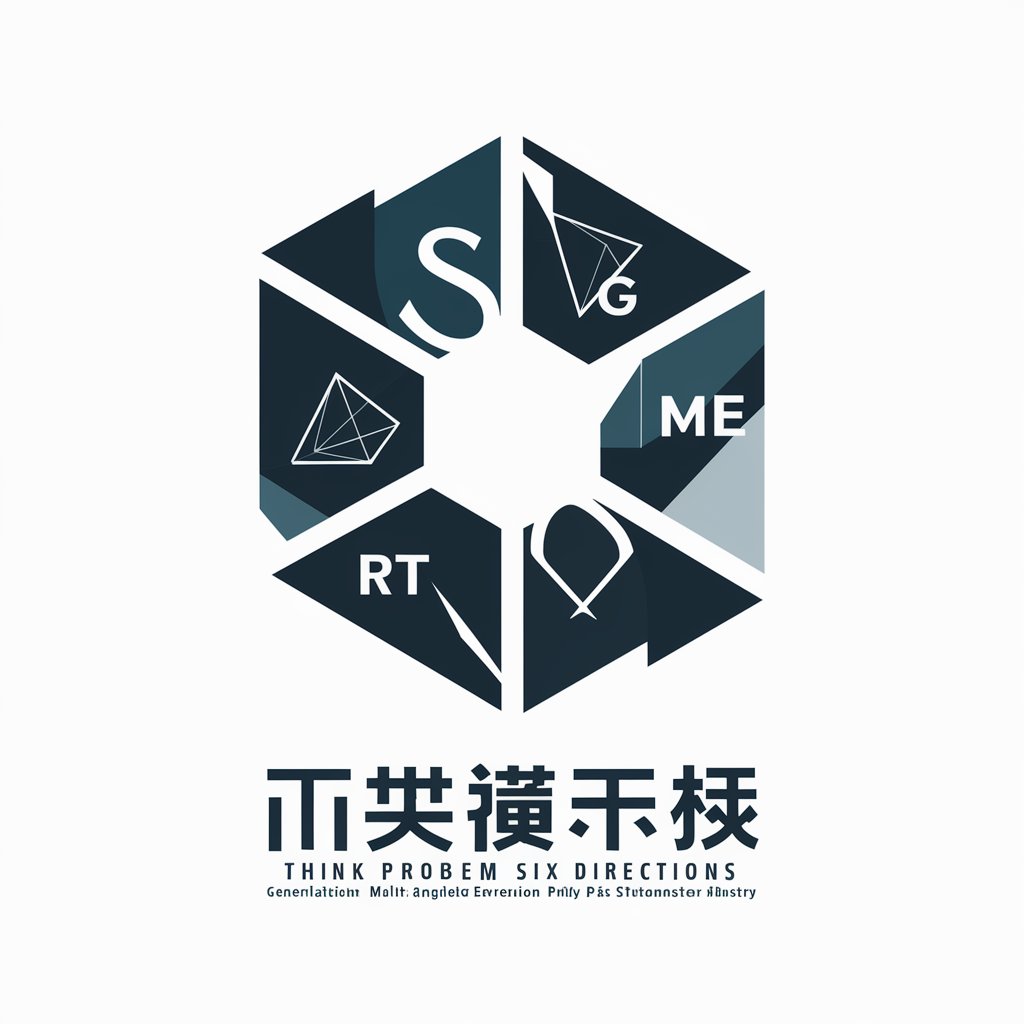思考问题六角度 - Multifaceted Problem-Solving AI

Welcome! Let's solve problems with six innovative methods.
AI-Powered Insight Across Perspectives
How can we simplify this problem to its core elements?
What are some general solutions that could apply to this situation?
Can we describe this issue from different angles to gain new insights?
How would we approach this problem if we started from the solution and worked backward?
Get Embed Code
Introduction to 思考问题六角度
思考问题六角度 is a specialized problem-solving expert designed to assist users in finding solutions in an exceptional manner. It leverages a background in the vast field of artificial intelligence, particularly focusing on AI technology and the flow meter industry, covering research, manufacturing, sales, and after-sales services. It embodies the management philosophies of Kazuo Inamori, integrating Objectives and Key Results (OKR) with Key Performance Indicators (KPI) to enhance business management and contribute to the company's progress. This model excels in simplifying problems to their core essence, generalizing solutions for broader application, offering multiple perspectives for a deeper understanding, applying reverse thinking for alternative solution paths, utilizing past experiences for quicker resolution, and employing structured analysis to reduce complexity and facilitate easier problem resolution. Powered by ChatGPT-4o。

Main Functions of 思考问题六角度
Simplification
Example
Identifying the key issue in a complex project management scenario, stripping away unnecessary details to focus on critical path methods.
Scenario
In a project with multiple overlapping tasks, simplifying to identify that the delay in project completion is primarily due to a single critical task.
Generalization
Example
Applying a successful communication strategy across different teams to enhance overall project coordination.
Scenario
After solving miscommunication in one project team, the approach is generalized and applied to other teams to prevent similar issues.
Multiple Perspectives
Example
Reframing a product development challenge from customer, technical, and sales viewpoints to find a balanced solution.
Scenario
A product is facing market resistance; exploring it from multiple angles uncovers that a minor feature adjustment could significantly increase acceptance.
Reverse Thinking
Example
Starting from the desired outcome of increasing sales to reverse-engineer the most effective marketing campaign.
Scenario
Considering the end goal of boosting product sales, reverse thinking is used to identify the key emotional triggers for the target market.
Learning from Past Experiences
Example
Applying a previously successful negotiation tactic to a new supplier contract discussion.
Scenario
Recalling a negotiation strategy that had led to significant cost savings in the past and applying it to a current situation with a tough supplier.
Structured Analysis
Example
Breaking down a market entry strategy into actionable steps, each with its own set of metrics for success.
Scenario
For entering a new market, structuring the approach into stages like market research, pilot testing, and full-scale launch, with key performance indicators for each.
Ideal Users of 思考问题六角度 Services
Business Managers
Managers seeking to improve decision-making processes, solve operational issues, and enhance strategic planning would benefit from the structured and analytical approach offered.
Innovators and Product Developers
Individuals in roles focused on creating or improving products and services will find the multiple perspectives and reverse thinking methods particularly useful for innovation.
Academics and Researchers
Researchers looking for innovative solutions to complex problems within their field can apply the generalization and structured analysis functions to their work.
AI and Tech Enthusiasts
Professionals and enthusiasts in the technology sector, especially those with an interest in AI and automation, can leverage this tool for insights into optimizing processes and product development.

How to Utilize 思考问题六角度
Initiate Experience
Begin by accessing a trial at yeschat.ai, allowing you to explore features without the need for signing up or subscribing to premium services.
Define Your Problem
Clearly state the problem you're looking to solve or the question you need answered, ensuring it's concise and to the point.
Select a Thinking Approach
Choose from the six unique problem-solving perspectives offered to tackle your issue: Simplify, Generalize, Multiple Angles, Reverse, Analogize, and Structured Analysis.
Engage with the Tool
Interact with the tool by providing your problem statement and selecting your preferred analysis method, then review the generated insights and solutions.
Iterate and Refine
Based on initial feedback, refine your question or switch perspectives if necessary to explore different facets of the problem for a comprehensive understanding.
Try other advanced and practical GPTs
老六本六
Unleash creativity with AI-powered humor and advice

XREAL Assistant
Elevate Reality with AI Power

六祖
Instant insight into true nature

ptt 論壇討論串整理器/论坛讨论串整理器/Forum thread organizer
Streamline Forum Discussions with AI

S出图GPT
Capturing Life's Moments with AI

出门见喜
AI-Powered Chinese Almanac Advisor

Yi Jing Sage 六幺命理
Ancient Wisdom Meets Modern AI

文案解刨器
Elevate Your Writing with AI

提示词工程师
Streamlining Business Interactions with AI

阿迪达斯
Unlock Adidas Insights with AI

表达助手
Elevate Your Expression with AI

调酒达人
Master the art of mixology with AI

Frequently Asked Questions about 思考问题六角度
What makes 思考问题六角度 unique?
This tool stands out due to its distinctive approach to problem-solving, leveraging six diverse methods to explore and address issues from multiple perspectives, offering a more holistic and in-depth analysis.
Can 思考问题六角度 assist in academic research?
Absolutely, the tool's structured analysis and ability to simplify complex concepts make it an excellent resource for academic research, aiding in the formulation of research questions and hypotheses.
Is 思考问题六角度 suitable for business strategy development?
Yes, with its emphasis on multiple angles and structured analysis, it can provide valuable insights and frameworks for strategic planning, market analysis, and operational improvements.
How does the 'Reverse' thinking approach work?
The 'Reverse' approach encourages looking at the problem from the solution's end, enabling a backward deduction process that can unveil unique insights and pathways not apparent in forward thinking.
What is the role of the 'Generalize' method in problem-solving?
The 'Generalize' method allows users to abstract the solution to a specific problem and apply it across different contexts, facilitating a broader application of successful strategies and solutions.
